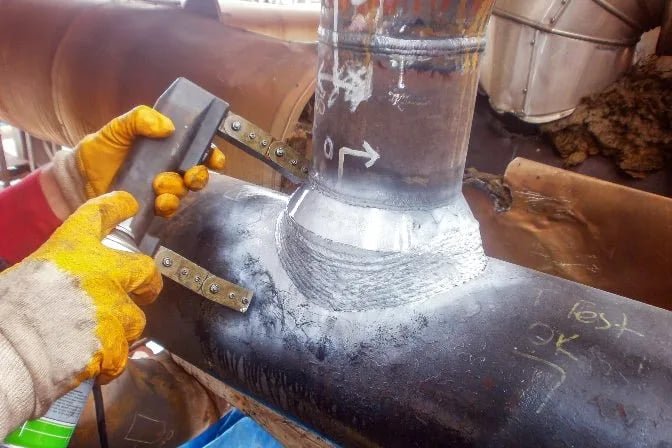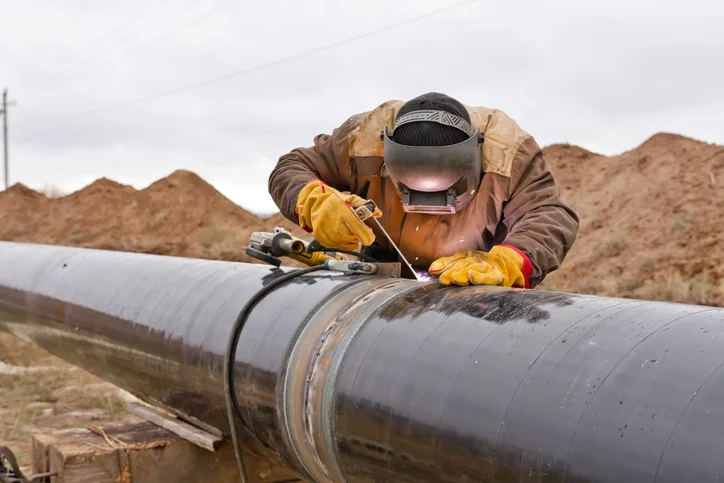Keep Code-Compliant: Professional Pipeline Welding Inspection Tailored to Your Demands
Keep Code-Compliant: Professional Pipeline Welding Inspection Tailored to Your Demands
Blog Article
Comprehensive Summary of Pipe Welding Evaluation Treatments
Pipe welding assessment treatments play a crucial role in guaranteeing that welded links satisfy rigorous industry requirements and specs. From meticulous pre-welding evaluations to thorough post-weld evaluations, a well-defined examination procedure is important for preserving the architectural strength of pipes.
Pre-welding Evaluation Preparations
Before commencing the welding procedure, comprehensive pre-welding inspection prep work are vital to ensure the stability and quality of the weld joint. These preparations entail a precise evaluation of the products to be bonded, the welding tools, and the workplace. Firstly, the products must be examined for any kind of flaws, pollutants, or disparities that can endanger the weld. This includes monitoring for appropriate product grades, measurements, and surface conditions. Pipeline Welding Inspection. Furthermore, the welding devices requires to be inspected to confirm that it is in excellent working condition, adjusted properly, and appropriate for the details welding process. Any issues with the tools must be dealt with without delay to stop defects in the weld. The job atmosphere should be reviewed for sanitation, appropriate air flow, and safety and security measures to guarantee a favorable setup for the welding procedure. By performing complete pre-welding evaluation preparations, potential concerns can be identified and resolved at an early stage, bring about high-quality and trustworthy weld joints.
Welding Treatment Certification
Thorough pre-welding inspection preparations lay the structure for the essential procedure of Welding Procedure Certification, guaranteeing the stability and quality of the weld joint. Welding Procedure Certification (WPQ) is a crucial action in the welding procedure that entails testing and licensing welding procedures to guarantee they meet certain standards and demands. The WPQ process commonly includes welding treatment requirements development, welding treatment certification testing, and documents of the results.
Throughout welding procedure requirements advancement, crucial details such as the welding process, welding products, joint layout, and welding parameters are defined to produce a detailed procedure. Subsequently, welding treatment qualification testing is performed to confirm the proposed treatment's stability. This testing typically involves welding test promo codes that undergo numerous mechanical and non-destructive tests to analyze the weld's high quality and adherence to the specified standards.
In-process Weld Inspection
During the welding process, in-process weld evaluation plays a crucial duty in ensuring the top quality and integrity of the weld joint - Pipeline Welding Inspection. This type of inspection entails monitoring the welding parameters, evaluating the weld bead formation, and finding any kind of prospective issues or gaps as they take place. By performing in-process weld assessments, welding drivers can immediately attend to any issues that might arise, consequently stopping more problems and making certain that the last weld fulfills the required requirements
Usual approaches utilized for in-process weld inspection consist of visual evaluation, liquid penetrant testing, magnetic particle testing, ultrasonic screening, and radiographic screening. Generally, in-process weld assessment is vital for maintaining the quality and reliability of bonded pipes.
Non-destructive Testing (NDT)
Non-destructive Testing (NDT) is an essential method utilized in pipe welding assessment to examine the integrity of weld joints without triggering damages to the welded framework. By using different NDT techniques, assessors can examine the quality of welds and determine any kind of problems or interruptions that might compromise the structural stability of the pipe. Usual NDT approaches utilized in pipe welding examination include Radiographic Screening (RT), Ultrasonic Testing (UT), Magnetic Bit Checking (MPT), Fluid Penetrant Testing (LPT), and Visual Screening (VT)
RT entails the use of X-rays or gamma rays to generate photos of the internal structure of the weld, enabling inspectors to detect flaws such as porosity, splits, or incomplete fusion. UT makes use of high-frequency acoustic waves to identify flaws beneath the surface of the weld, providing comprehensive information regarding the dimension and place of problems. MPT and LPT are utilized to identify surface-breaking defects by applying penetrant fluids or magnetic bits to the go to this site weld area. In addition, VT entails visual evaluation of welds to identify any type of visible flaws.
Post-weld Evaluation and Documents

Documents of post-weld inspection searchings for is crucial for preserving about his quality assurance documents and making certain compliance with sector requirements and guidelines. Detailed reports need to include details about the evaluation techniques utilized, the area and nature of any issues discovered, and any type of corrective activities taken - Pipeline Welding Inspection. Appropriate documentation not only acts as a record of the weld's high quality but additionally help in future upkeep and inspection procedures
Final Thought

In conclusion, pipeline welding evaluation treatments play a crucial function in making certain the top quality and honesty of welds. In general, adherence to proper examination protocols is essential to the success of pipeline welding jobs.
From careful pre-welding examinations to comprehensive post-weld evaluations, a distinct evaluation process is vital for maintaining the architectural strength of pipes. By conducting in-process weld examinations, welding operators can quickly resolve any type of concerns that may occur, thereby stopping additional issues and ensuring that the last weld meets the needed his response requirements.
Typical approaches used for in-process weld assessment include visual assessment, liquid penetrant testing, magnetic fragment screening, ultrasonic screening, and radiographic testing.Non-destructive Testing (NDT) is a critical technique used in pipe welding examination to examine the honesty of weld joints without causing damages to the welded structure. Post-weld evaluation involves various approaches to assess the welds for defects, consisting of visual assessment, color penetrant screening, magnetic bit screening, ultrasonic testing, and radiographic testing.
Report this page